Interior Design Trends in Dubai's Real Estate Market
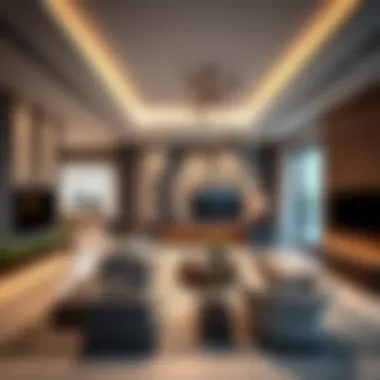
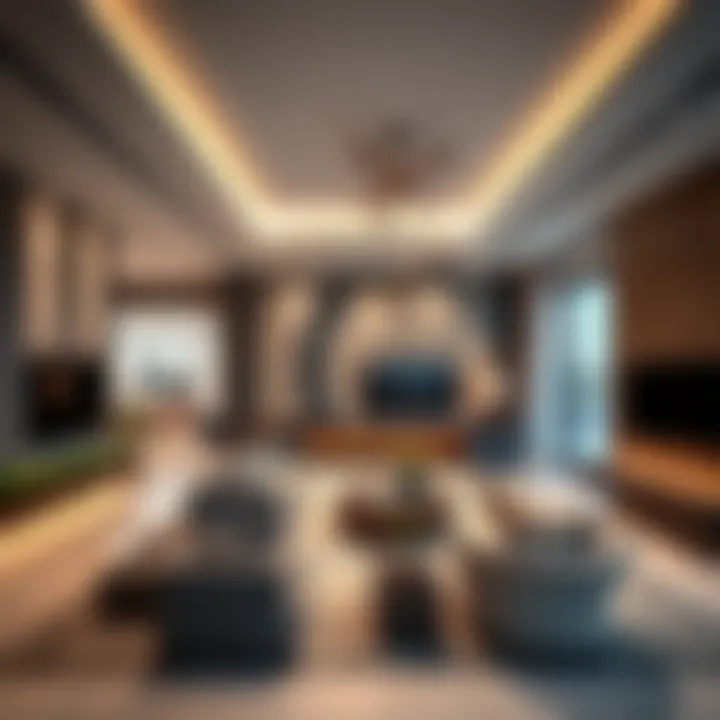
Intro
Dubai stands out as a jewel in the desert, and its real estate market is a reflection of this vibrant metropolis. The interior design landscape within this sector is not just a mere enhancement of aesthetics; it’s intertwined with property values, functionality, and the cultural essences that define the emirate. As urban living evolves, the demand for innovative and sophisticated designs continues to rise. In this article, we’ll peel back the layers of Dubai’s interior design cosmos, exploring how current trends, investment opportunities, and cultural influences sculpt the environments we inhabit.
Market Insights
Current Trends in Dubai Real Estate
Dubai’s property market is an ever-changing beast. Modern buyers and renters are increasingly looking for spaces that resonate with personal style, comfort, and practicality. It’s not just about having four walls anymore; it’s about creating an experience. The surge in luxury living has spurred designers to push the envelope further.
Several trends have taken center stage:
- Biophilic Design: Integrating natural elements through plants and natural light creates a serene living environment.
- Sustainable Materials: Eco-friendly options like reclaimed wood and low-VOC paints are gaining preference.
- Smart Home Technology: Automation for convenience and luxury is a norm in upscale developments.
In adapting to these trends, designers are not just beautifying spaces but also making them more functional and responsive to residents' needs. They’re keeping an ear close to the ground, listening to the whispers of consumer demands and adapting designs accordingly.
Future Predictions and Market Analysis
Looking towards the future, it’s clear that the intersection between design and technology will further redefine Dubai’s real estate landscape. Expect to see an increase in sustainable architecture as the Dubai government solidifies its commitment to eco-friendly initiatives.
- Emerging Neighborhoods: Areas like Dubai Creek Harbour and Al Quoz are on the rise, blending modernity and cultural heritage seamlessly.
- Integrative Spaces: As urban density increases, multi-functional areas where living, working, and leisure converge will gain traction.
This ever-evolving market requires stakeholders to stay nimble and innovative. Investors, realtors, and designers must understand not only current preferences but also anticipate shifts to remain ahead of the curve.
"Understanding the nuances of the furniture, colors, and layouts can significantly sway potential buyers' perceptions on property value, making it an essential aspect of real estate investment."
Investment Opportunities
Real estate in Dubai is ripe with opportunities, but knowing where to invest can set you apart from the rest.
High-ROI Property Areas
Certain neighborhoods promise higher returns than others, thanks in part to emerging design trends that attract discerning buyers. Notable locations include:
- Downtown Dubai: Familiar to most for the Burj Khalifa, this iconic area remains a hot spot for luxury living.
- Dubai Marina: The high-rise apartments here cater to both local and international expats, maintaining strong demand.
- Jumeirah Village Circle (JVC): An emerging favorite among families due to its extensive amenities and lower price points.
Investing in these areas not only ensures a sound financial return but also aligns with the growing interior design movement.
Tips for First-Time Investors
For newcomers to the market, diving into property investment can feel overwhelming. Here are some practical tips:
- Research Thoroughly: Familiarize yourself with current market trends, developments, and local prices.
- Understand Legalities: Regulations can be complex, so consulting with a local expert is invaluable.
- Seek Unique Designs: Properties with innovative designs often attract higher interest and faster sales.
Taking a careful approach to investing will not only bolster your financial standing but will also provide you a place in the ever-changing Dubai real estate narrative.
Closing Thoughts
Exploring the interior design landscape in Dubai’s real estate market reveals a robust layer to the architecture and spaces we often take for granted. As consumers evolve, so will the designs, which remain critical to enhancing the overall living experience. For investors and stakeholders, understanding this dynamic relationship is key to navigating this market successfully.
For more information related to Dubai's real estate market and interior design trends, consider visiting Wikipedia or Britannica.
An engaged interest with local forums such as Reddit can also provide real-time insights and experiences related to properties in Dubai.
Prolusion to Interior Design in Dubai
When we talk about the bustling heart of the UAE, it's impossible to ignore the role of interior design. In Dubai, an energetic mix of cultures, traditions, and a fast-paced economy shapes the designing of spaces. This artistic approach is not merely about filling a room with furniture; it transcends that. Interior design plays a crucial role in defining the character, style, and functionality of properties, which ultimately affects their marketability and value. For home buyers and investors alike, understanding design trends becomes imperative when navigating this competitive landscape.
The Significance of Interior Design
Interior design in Dubai serves as a barometer for expat lifestyles, luxury standards, and cultural fusion. The significance cannot be overstated. In today's real estate market, where properties are aplenty, having a well-designed space can be the deciding factor for potential buyers. Unique designs enhance the appeal of residential units, shaping perceived value. In essence:
- Aesthetic Value: Good design can transform a mundane space into a visual wonder, influencing emotional responses. Buyers are often swayed by beauty.
- Functionality: Beyond looks, effective design ensures a space works well for its intended purpose. Whether it’s maximizing storage in a small apartment or ensuring smooth flow in a larger home, clever layouts add value.
- Cultural Relevance: Integrating local traditions imbues a sense of place, creating an ambiance that resonates with both local and foreign residents.
In brief, what's designed well draws people in and keeps them connected to their surroundings.
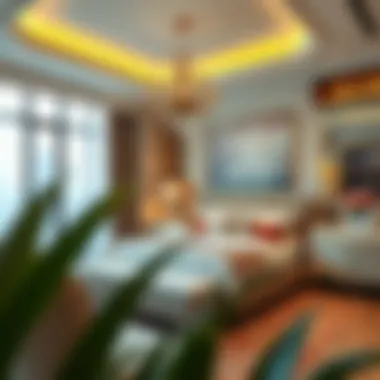
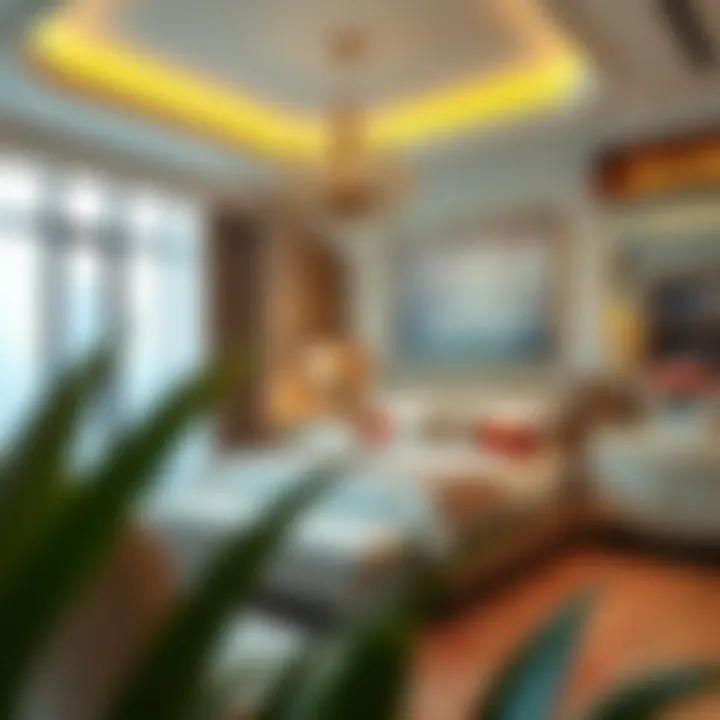
Overview of the Dubai Real Estate Market
Understanding the Dubai real estate market is foundational for appreciating its interior design sector. Over the years, this market has seen fluctuating trends, shaped largely by global economic conditions and investment sentiments. Recently, it has been an arena of active growth thanks to:
- Diverse Offerings: From opulent villas in Palm Jumeirah to sleek apartments in Downtown Dubai, the variety caters to multiple tastes and budgets.
- Strong Demand: There’s a continually rising appetite for property, fueled by a blend of local buyers, expatriates, and international investors looking for high returns.
- Regulatory Changes: Initiatives like long-term visas for investors have sparked new interest, allowing more people to call Dubai home.
The facts are clear: the interplay between real estate and interior design defines how spaces are marketed and priced. With every project, the design becomes an essential aspect of creating a unique selling proposition in a crowded marketplace.
Key Trends in Dubai's Interior Design
In a city renowned for its architectural marvels and opulent lifestyle, the significance of interior design cannot be overstated. The trends shaping Dubai's interior design landscape reflect the cultural richness, rapid advancements in technology, and the growing emphasis on sustainability. These trends are not merely aesthetic choices; they carry weight in functional aspects and property value, impacting investors, developers, and residents alike. Therefore, understanding these key trends is essential for anyone involved in the region's real estate market.
Minimalism vs. Opulence in Design
The design ethos in Dubai is a tug-of-war between minimalism and opulence. On one hand, you have minimalism which emphasizes clean lines and uncluttered spaces. This style aims to create tranquility and clarity in environments bombarded by Dubai's fast-paced lifestyle. Think of bright neutral palettes and sparse furniture – ideal for those who prefer a sophisticated simplicity.
Conversely, opulence reigns in many luxury residences and high-end commercial spaces. Designers often harness extravagance through lavish materials, intricate detailing, and bold colors. Amber lighting chandeliers, upholstered wall panels, and custom Italian furniture create luxurious vibes. Potential buyers and renters frequently find themselves attracted to this lavish aesthetic, which mirrors the glamorous lifestyle the city represents.
- "The balance aboard between minimalism and opulence is a dance. Designers are the choreographers weaving together the best of both worlds."
This duality offers a rich tapestry of options for interior designers, allowing them to cater to a broad spectrum of clients and tastes, ultimately affecting property marketability.
Integration of Local Culture in Design Choices
Understanding the cultural nuances is key in creating spaces that resonate with the residents of Dubai. The integration of local art, textiles, and artisan craftsmanship not only establishes authenticity but also deepens the connection to the Emirati heritage. From intricate mashrabiya screens that lend privacy, to the use of vibrant handwoven rugs, local culture is a canvas that enhances modern design.
Homeowners are increasingly seeking to express their identity through designs that reflect personal history and tradition. This enhances the aesthetic beauty while simultaneously lending a story to each space. Notably, the incorporation of Arabic architectural elements brings a timeless quality that sets projects apart in an oversaturated market.
Sustainable and Eco-friendly Designs
As the world shifts toward eco-consciousness, Dubai's interior design landscape reflects this priority with sustainable practices taking center stage. Designers are becoming more mindful of materials, opting for products that are not only aesthetically pleasing but also environmentally responsible. Bamboo flooring, recycled metal fixtures, and low-VOC paints are just a few examples that align with this philosophy.
Investors are also beginning to recognize the tangible benefits of sustainable design. Spaces that prioritize energy efficiency, natural light, and sustainable materials tend to attract environmentally aware clients, yielding higher property values.
Incorporating greenery through biophilic design principles not only elevates air quality but creates a sense of wellness. This is particularly appealing in an urban environment where natural elements may be scarce.
By prioritizing sustainable choices, designers enhance the reputation of their brands, attracting a discerning clientele eager to invest in a future-friendly lifestyle.
This growing emphasis on sustainability is reshaping the conversation around interior design in Dubai, making it one of the most relevant trends in today's market.
Influence of Technology on Interior Design
Technology is steadily reshaping the world around us, and interior design is no exception. In Dubai's fast-paced real estate market, the integration of technology into design is not just a fad; it's a necessity that can enhance aesthetics, efficiency, and overall value of properties. As investors, developers, and property managers strive to keep up with evolving consumer preferences, understanding the role of technology in design becomes paramount. The blend of functionality with innovation offers not only enhanced living experiences but also aligns with the demands of modern buyers who prioritize convenience and sophistication.
Smart Home Technologies
Smart home technologies have become a buzzword in Dubai's interior design scene. These technologies integrate household devices and appliances with the Internet, allowing homeowners to control everything from lighting to climate using their smartphones. Imagine adjusting the thermostat from the comfort of your bed or ensuring your security system is activated while vacationing abroad. The benefits are clear: enhanced comfort, increased energy efficiency, and improved security, which appeal strongly to today's tech-savvy homeowners.
- Key Benefits of Smart Home Technologies:
- Enhanced user control and convenience.
- Reduction in energy consumption leading to cost savings.
- Increased home security features via remote monitoring.
- Seamless integration with existing home decor, preserving aesthetic value.
Moreover, the rise of IoT (Internet of Things) devices has paved the way for conversations about sustainability within interior design. For instance, smart thermostats not only improve comfort but also help track and manage energy usage. This aspect aligns with the growing trend towards eco-friendly designs, making properties more appealing to environmentally conscious buyers.
Virtual Reality in Design Visualization
Virtual Reality (VR) is another transformative technology making waves in the interior design industry. The ability to create immersive environments allows clients and designers to visualize their spaces before any physical alterations begin. This technology mitigates the risk of misunderstandings and costly mistakes, transforming the traditional design process into an interactive experience.
- Advantages of Virtual Reality:
- Enables clients to experience spaces in a fully immersive way, thus enhancing decision-making.
- Saves time and resources by allowing for adjustments in designs before finalization.
- Provides a cutting-edge marketing tool for properties, making them more attractive to potential buyers.
Incorporating virtual reality into the design process serves not only practical purposes but also creative ones. Designers can experiment with color schemes and layout changes effortlessly, offering a more dynamic approach to planning. While the initial investment in VR technology may seem steep, the long-term benefits—such as elevated client satisfaction and enhanced property value—underscore its importance.
Technology enhances not just the aesthetic appeal in design but also tailors the living experience to the needs of the occupants, ensuring that every space resonates with modern living.
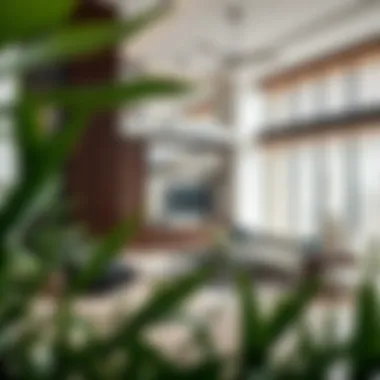
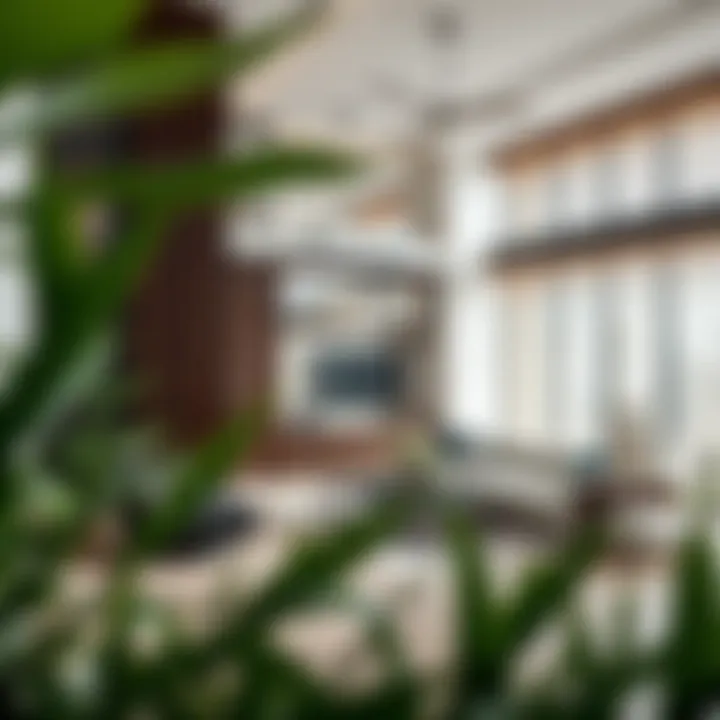
Prominent Interior Design Firms in Dubai
When examining Dubai's bustling real estate market, the significance of interior design firms can't be overstated. These firms not only shape the visual and functional aspects of properties but also reflect the cultural tapestry of the region. Their expertise impacts investor decisions and enhances the living experience for residents. Understanding the role of these firms provides valuable insights into the forces that drive property value and appeal.
Profiles of Leading Design Companies
Design Firm A
One of the standout names in the Dubai design landscape is Design Studio X. Known for its bespoke approach, the firm tailors each project to the specific needs of the client. Their hallmark characteristic is a keen eye for detail and commitment to blending luxury with functionality. This makes Design Studio X an appealing choice for discerning investors seeking distinctive properties that command higher market values.
A unique feature of Design Studio X is its emphasis on local artisans and craftsmanship, which not only supports the community but also adds an authentic touch to their projects. However, their tailored approach can sometimes lead to longer turnaround times, as each design is carefully curated rather than following standardized templates.
Design Firm B
On the other hand, there's Modern Interiors Group, which epitomizes sleek, contemporary design. This firm is widely regarded for its innovative use of technology in creating immersive spaces that appeal to today’s tech-savvy clientele. Their ability to integrate smart technology within design makes them a top pick for investors looking to elevate property value, especially in high-demand areas.
What sets Modern Interiors Group apart is their focus on sustainability, incorporating eco-friendly materials and practices in their projects. This focus aligns well with the growing market trend towards green living. However, their modern aesthetic might not appeal to everyone, particularly clients who favor traditional design elements.
Emerging Designers to Watch
As Dubai's design environment rapidly evolves, new talent is emerging, bringing fresh perspectives and innovative ideas. Keep an eye on Aisha Design Co. and Creative Visionary Studio, as both are making waves with their ingenious designs and commitment to sustainability. These emerging designers emphasize community-centric spaces that resonate with contemporary living while honoring the rich cultural heritage of the region.
The Role of Interior Design in Property Valuation
Interior design plays a fundamental role in enhancing property value within Dubai's dynamic real estate market. As the city continues to be a hub of innovation and luxury, the way a space is designed can significantly impact its marketability and overall worth. Its influence encompasses not only the aesthetics of a property but also its functionality, sustainability, and how well it resonates with the target demographic.
A thoughtfully designed interior can provide a sense of luxury and comfort, inviting potential buyers and renters to see not just a house, but their future home. Factors such as layout efficiency, style cohesion, and the choice of materials contribute heavily to the perceived value of a property. As investors and developers navigate this landscape, understanding the nuances of interior design is more than a preference—it's a necessity.
How Design Affects Property Market Value
When it comes to valuation, design elements have a demonstrable effect on property prices. Here are a few ways interior design shapes market value:
- Curb Appeal: First impressions matter. An inviting entrance with well-thought-out design can entice potential buyers. Features like high-quality finishes and a cohesive color scheme can create a lasting impact.
- Space Optimization: Smart layout designs maximize usable space, which not only enhances functionality but makes properties appear larger than they may actually be. This optimization directly correlates with higher valuations.
- Trend Adaptation: Incorporating contemporary design trends can keep a property competitive in a fluctuating market. For example, integrating eco-friendly materials and smart home technology can significantly bolster property appeal.
- Memorable Features: Unique design elements, such as bespoke cabinetry or artistic light installations, can prompt buyers to pay a premium for distinctive features that stand out in a crowded market.
Even in the luxury sector, where interior design plays a major role in attracting high-net-worth individuals, it is evident that a lack of attention to design basics can drag down property values.
"In Dubai's competitive landscape, a property with superior design can command prices that far exceed similar offerings without proper aesthetic consideration."
Investor Considerations in Design
For investors in Dubai's real estate landscape, design is not just an expense—it's an investment. When considering properties, several factors should be kept in mind:
- Market Trends: Stay informed about the prevailing design trends in the Dubai real estate market. Properties that reflect current consumer preferences for sustainable and luxury living can retain their value more effectively.
- Target Audience: Before making design choices, understanding the demographic you are looking to attract is key. High-end designs may appeal to affluent buyers, while family-friendly layouts may draw in young families seeking community.
- Long-term Viability: Choose designs that have lasting appeal rather than opting for trendy elements that may wear out quickly. This fosters longevity and keeps properties from becoming obsolete.
- Regulatory Compliance: Navigating Dubai’s regulatory landscape can be complex. Ensure that your design choices are in compliance with local building codes and standards to avoid costly revisions.
- Collaborate with Professionals: Engaging with experienced interior designers can be invaluable. These professionals bring expertise in aesthetics, functionality, and regulatory requirements that can save time and elevate the property's value.
Navigating through these considerations allows investors to leverage interior design as a powerful tool in the valuation and market positioning of real estate investments. With a meticulous approach, the dividends of thoughtful interior design can be substantial, reflecting in both the aesthetic and financial yields.
Challenges Faced by Interior Designers
Navigating the bustling and often chaotic world of interior design in Dubai's real estate market comes with its fair share of challenges. Understanding these hurdles not only offers insight for existing professionals but also prepares aspiring designers and investors looking to tap into this vibrant market. The importance of discussing these challenges is paramount, as it provides a clear-eyed view into the complexities of balancing creative aspirations with the practicalities of market demands.
Balancing Client Expectations with Reality
When it comes to interior design, one of the most significant challenges designers face is balancing client expectations with the often harsh realities of budgets, timelines, and spatial limitations. Clients may enter the process with high hopes, picturing extravagant designs inspired by celebrity homes or luxury lifestyle magazines. However, the truth is that factors like costs, available materials, and structural variables can severely limit the implementation of such grandiose visions.
In numerous cases, clients might also be unaware of the creative process involved, leading to misunderstandings about what can truly be achieved. Designers need to cultivate strong communication skills to manage these expectations effectively. Regular presentations, involving clients in the decision-making process, and providing them with realistic visualizations can help bridge the gap.
For example, if a client aims for an ultra-modern open-concept design but their apartment's layout prohibits major structural changes, designers must tactfully point out these constraints while still capturing the client's vision in a feasible manner. This delicate dance between aspiration and reality not only ensures client satisfaction but also protects the designer's reputation in a highly competitive marketplace.
Navigating Regulatory Requirements
Another formidable challenge interior designers face in Dubai is navigating the myriad of regulatory requirements that often accompany any real estate project. Dubai has a robust set of laws and guidelines governing building codes, environmental considerations, and safety standards, all of which can significantly impact the design process.
Understanding local regulations is essential for ensuring compliance, but designers often find the bureaucratic landscape cumbersome and somewhat opaque. This is particularly true for expatriate designers who may not be familiar with local customs or regulations.
Designers must stay updated on various approvals needed from authorities like the Dubai Municipality or Dubai Development Authority. Missing a single compliance requirement can delay projects and lead to potential legal ramifications. As such, establishing relationships with regulatory bodies or hiring local consultants can be wise strategies to alleviate these challenges.
Additionally, with Dubai's ambition to become a global hub for innovation and eco-friendliness, designers need to integrate sustainable practices into their designs while still adhering to these regulations. This balancing act isn't just a challenge but also a pivotal opportunity for designers to showcase their creativity in sustainable design while remaining compliant.
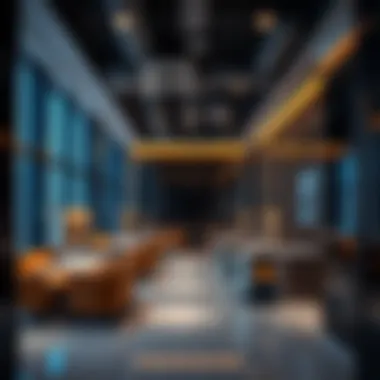
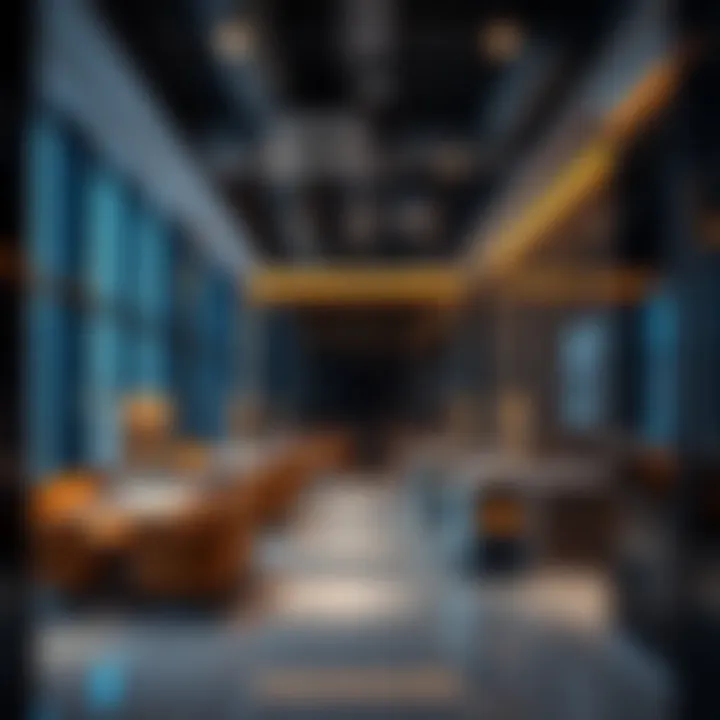
"Success in design is not just about aesthetics; it's also about aligning vision with reality, constitution with creativity."
As the interior design landscape evolves in Dubai, bringing fresh ideas and ensuring processes are followed is crucial. Tackling these challenges head-on will empower designers to excel and solidify their stature in this thriving market.
Cultural Influences on Design Choices
Understanding cultural influences in interior design is essential, especially in a melting pot like Dubai. The blend of diverse heritages and modern sensibilities creates a unique design language. When planning interiors, designers must consider not only aesthetics but also the cultural narratives that resonate with residents and visitors alike. This cultural tapestry has significant implications on design choices, ensuring spaces reflect the identity and values of their inhabitants.
Reflection of Heritage in Modern Design
Heritage plays a vital role in shaping contemporary interior designs in Dubai. This region is steeped in rich traditions that date back centuries. Designers often look to these roots when creating modern spaces, merging historical influences with today’s functionality. For instance, traditional Arabic calligraphy, geometric patterns, and decorative motifs frequently find their way into contemporary homes, serving as a bridge between past and present.
- Textiles and Materials: Many designers incorporate locally sourced materials, such as ornate woodwork and intricate tile designs, that echo the historical craftsmanship of the region.
- Color Palettes: Earthy tones and vibrant hues often reflect the vibrant landscapes of Dubai’s deserts and coasts, offering a sense of place.
- Architectural Elements: High ceilings, open courtyards, and mashrabiya screens not only enhance airflow but pay homage to traditional designs that have stood the test of time.
The result is a harmonized aesthetic that honors heritage while catering to the modern demands of comfort and luxury. Spaces become more than just places to live; they transform into living archives of cultural narratives, creating a profound emotional connection for occupants.
The Importance of Community Spaces
In the context of Dubai’s rapidly expanding real estate landscape, the significance of community spaces in interior design cannot be overstated. These spaces foster interaction and connectivity, allowing diverse populations to come together, share experiences, and build relationships.
- Designing for Social Interaction: Thoughtfully designed communal areas, such as lounges, parks, and recreational amenities, promote socializing and community engagement, essential in urban environments.
- Cultural Events and Activities: Spaces that accommodate local art exhibitions or traditional performances not only serve practical purposes but also celebrate and promote Dubai's multicultural roots.
- Focus on Inclusivity: Recent design trends emphasize accessibility, ensuring that community spaces cater to all people, regardless of age or ability, thereby enhancing the quality of life for an expansive demographic.
The strategy behind the integration of community spaces into the design ethos essentially reflects a broader understanding of well-being and social cohesion. As such, these areas enhance the overall value of properties, attracting investors who recognize the importance of lifestyle considerations in real estate decisions.
In summary, cultural influences in interior design not only shape the aesthetic appeal of spaces but also enrich the living experience, making it vital for designers and investors to appreciate these dimensions fully.
Relevant Resources
Future Directions in Interior Design
The world of interior design is not stagnant; it’s constantly shifting, especially in a dynamic market like Dubai. The future directions in this field are crucial to grasp for anyone involved in the real estate sector, from investors and developers to designers and property managers. Understanding these emerging trends can guide design choices that not only cater to current residents but also attract future buyers or renters.
In this section, we will explore the expected shifts in consumer preferences and the innovative materials and techniques that are shaping the new landscape of interior design in Dubai.
Expected Shifts in Consumer Preferences
Over the coming years, consumer preferences in interior design are expected to evolve significantly. Today's buyers are not only looking for beautiful spaces, but they also prioritize functionality, sustainability, and personal expression in their homes.
- Sustainability: There's a growing consciousness about environmental issues. Buyers now often seek eco-friendly homes. This trend means using sustainable materials and energy-efficient designs will become commonplace. Developers should think about sourcing locally and minimizing waste as sound strategies.
- Personalization: Homeowners want to express individuality and culture within their spaces. This means that interior designers have to pay close attention to personal style preferences. For instance, touches of local artistry or custom furniture might be favored to give that unique flair.
- Functional Spaces: As lifestyles change, there’s a demand for multifunctional spaces. Homes that can easily adapt for remote work, for instance, are likely to be more desirable.
"The future of interior design in Dubai hinges on adaptability. By designing spaces that can evolve with lifestyle changes, investors can stay ahead of the curve."
Innovative Materials and Techniques
Innovation is the name of the game in interior design. New materials and techniques not only enhance aesthetic appeal but also improve functionality and sustainability in homes. Designers in Dubai are exploring a plethora of options that push the envelope for what's possible.
- Recyclable and Biodegradable Materials: The rise of green building practices has led to an increased use of materials that can be recycled after use or are biodegradable. This includes everything from wall coverings to flooring, offering both aesthetic appeal and environmental responsibility.
- Smart Materials: These are engineered to respond dynamically to environmental changes. For example, a material that can change its color or texture based on temperature or the time of day could alter the perception of space in real-time.
- Advanced Technologies in Construction: Techniques like 3D printing and modular building are transforming how spaces are created. Such technologies allow for rapid construction and customization, making it easier to adapt designs based on specific client needs.
By staying current with future directions, stakeholders in Dubai's interior design landscape can ensure they align with market demands, catering to a clientele that is increasingly sophisticated and discerning.
The End
The exploration of interior design in Dubai's real estate market reveals the intricate weave of aesthetics, functionality, and cultural nuances that shape living spaces. This connection holds immense significance, especially in a city like Dubai, where the blend of tradition and modernity coexists like old friends. The choices made by homeowners and investors mold not only the face of a property but also its value in the competitive market.
Summary of Insights
In this article, we've traversed various dimensions that underline the importance of smart design choices:
- Key Trends: The opposition of minimalism and opulence offers buyers a appealing spectrum to choose from while navigating their preferences.
- Technological Influence: The rise of smart homes intertwines advanced tech with interior design, granting consumers unprecedented control over their environments.
- Cultural Reflection: Infusing local heritage into modern design not only honors history but serves as an enticing narrative for potential investors and residents alike.
- Sustainability: With rising awareness around eco-friendly practices, integrating sustainable materials becomes a vital consideration in enhancing property value.
This confluence of aspects ensures that interior design is more than just decoration; it's strategic investment in the future of properties in Dubai’s booming market. The focus on community spaces, for instance, enhances livability and adds an extra layer of appeal to prospective buyers.
The Enduring Impact of Interior Design
The legacy of interior design influences Dubai's real estate landscape profoundly. What is important for stakeholders to recognize is that well-thought-out designs speak volumes beyond visual appeal; they establish a narrative. A well-designed space not only accentuates luxury but also caters to the practical desires of the modern homeowner—comfort and functionality.
Investors, realtors, and developers must embrace interior design as a pivotal part of their strategies. Considerations for impactful design choices include:
- Adaptability: Spaces designed with flexibility can cater to diverse needs, attracting a wider pool of tenants and buyers.
- Cultural Resonance: By reflecting local heritage, properties can enhance their marketability, appealing to both expatriates and locals.
- Technological Integration: The incorporation of modern technologies not just improves user experience but also increases property value significantly.
In wrapping up, as Dubai continues its rise as a global hub, the enduring impact of well-considered interior design will be evident in the increased satisfaction of residents and investors alike. The market's emphasis on unique design narratives and sustainability will ensure that Dubai remains a trailblazer in the realm of real estate.















